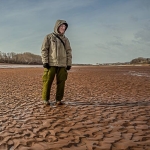Isaac De Razilly (1587-1635) is known as the founder of LaHave. De Razilly led the first successful attempt to establish French settlements in Nova Scotia, first in La Have and later at Port Royal. It was from Port Royal that the people we know as Acadians moved eastward to establish settlements in Kings County.
In Kings County the dykelands are often spoken of as an Acadian heritage, and properly so. The Acadians built aboiteaux, running dykes and crossdykes here, a work that beat back the sea, creating a wealth of fields and meadows that still exist today; and, of course, inspiring the Planters to continue the work.
This creating of the dykes may have been the Acadians undoing, but that’s another tale. However, we can speculate that the conquering of the sea and the rich farmlands the Acadians created were the envy of land hungry New Englanders and was a major factor spurring the expulsion.
In one sense, the dykes of Kings County and the Acadians are synonymous. However, I bet you didn’t know this about them: When De Razilly was setting up the French colony here, salt was nearly as valuable as gold, almost as scarce and so heavily taxed ordinary people couldn’t afford it. So, De Razilly thought, why not use the tides to raise salt water into dyked salt pans where it could be dried, creating a tax free surplus of this precious commodity.
Acting on his inspiration, De Razilly brought out experienced salters from France, men who were accustomed to dykeing. It was these men who convinced De Razilly valuable land could be wrested from the sea by dykeing rather than the current method of clearing land by hacking away at the forest. De Razilly’s salt industry was a failure but dykeing began here as a result of the salter’s arrival; you could say they came to make salt and stayed to build dykes, and we’re all the richer for it.
One of the oldest native Indian settlements in eastern Canada can be found in Debert, Colchester County. Based on radiocarbon dating, the area is believed to have been settled by Paleo-Indians (“Paleo” meaning old) well over 10,000 years ago. These early settlers may have crossed the Bering Strait from Asia into North America on a land and ice bridge, which some sources say existed anywhere from 14,000 to 47,000 years ago.
Eventually, many of the Paleo-Indians drifted in the Maritimes and down into Nova Scotia. The discovery of their settlement at Debert and the dating of artefacts found was an archaeological event of major significance, indicating man occupied Nova Scotia thousands of years before Europeans arrived. The explorations and discoveries of Champlain and De Monts almost pale in significance.
I’m sure you’ve heard about the ancient native site in Debert but I bet you didn’t know this about it: There’s a Kings County connection with its discovery
A native son of Kings County, Ernest Steckle Eaton, discovered the Debert site 1948. Born in Canning in 1923, he was the son of Ernest L. and Ellen S. Eaton of Upper Canard. Ernest Steckle Eaton attended school in Kentville, earned a degree in Arts from the University of Western Ontario and attended the NSAC and Prince of Wales College in Charlottetown.
It was while he was on the staff of the Agricultural College in Truro that Eaton discovered the native site. The artefacts he collected wound up in Kentville, in the hands of a collector who donated them to a Halifax university. The collector, W. A. Dennis, wrote about the artefacts and the native site in an American publication and this caught the attention of archaeologists here; a full scale investigation of the site was mounted and it was only then that the antiquity of the native settlement was realized.
As I said, this was a magnificent find. However, Ernest Steckle Eaton’s role in discovering the site has never been fully recognised. Perhaps one day he will be properly saluted for his find.
